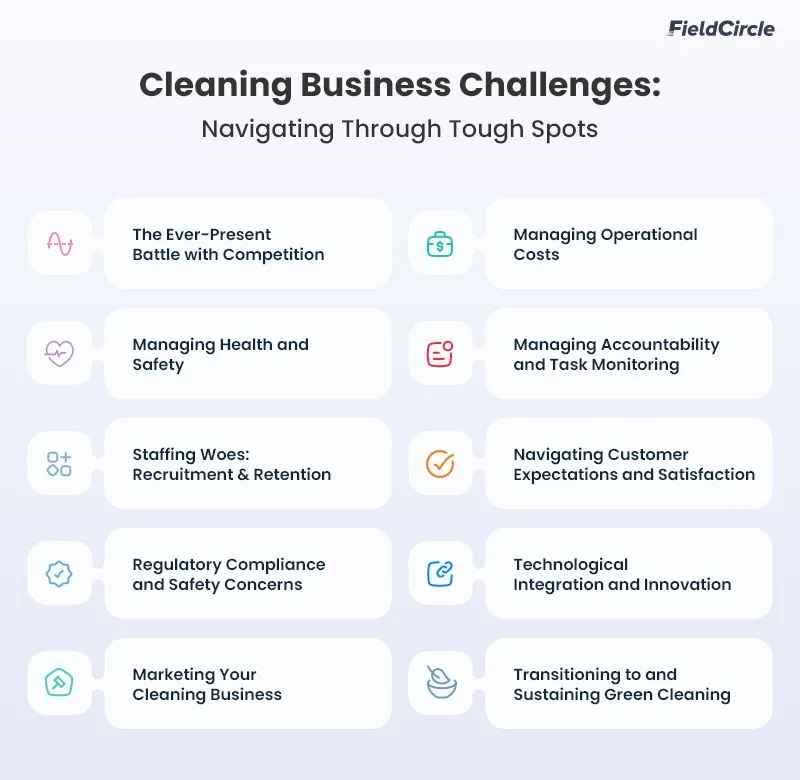Cleaning Business Challenges: Navigating Through Tough Spots

The cleaning industry, today, is incredibly different as compared to years gone by. The global janitorial service market size is poised to be valued at USD 322.95 billion by 2027, with the growth expected at a CAGR of 3.1% during the forecast period. With the growth has come evolving challenges around regulatory, technical, and environmental dimensions.
From managing schedules to addressing unexpected challenges on job sites, the responsibilities of a cleaning professional extend far beyond the surface level. Each encounter demands committed efforts, work ethics and professionalism, where a misstep can undermine the reputation of the entire janitorial business, and give opportunity to competitors.
In response to these challenges, innovative solutions tailored to the janitorial and cleaning industry have emerged to transform the way operations are managed. Far more than just scheduling tools, these solutions offer comprehensive suites of features designed to optimize workflows and enhance customer satisfaction.
What are these challenges and how can cleaning businesses overcome them? Read on to explore.
Biggest Challenges for Cleaning Businesses and How to Overcome them

The face of the cleaning industry is constantly changing and so too are challenges that the industry is witnessing from different corners. We look at the some of the biggest challenges that industry leaders have cited, and possible solitions to navigate through these challenges.
1. The Ever-Present Battle with Competition
In the United States alone, there are over one million janitorial service businesses that keep jostling for attention. What makes this arena particularly fierce is the ease with which newcomers can join the fray. With low startup costs, the barrier to entry is minimal, which can easily result in a flood of competitors. However, this influx often comes with a downside – most newcomers run the risk of prioritizing quantity over quality, cutting corners on both service and pricing.
There are companies that offer similar services. So, if you are into residential cleaning, you will see that there is no dearth of professional residential cleaners. The intense competition makes it difficult to distinguish oneself from the pack. While offering unique add-ons or specialized services might provide a temporary edge, it’s often insufficient in the long run.
Adding to the complexity, some clients of cleaning businesses are solely fixated on the bottom line, as they prioritize the lowest price above all else. With this comes an uphill task for higher-quality to justify their value proposition. Businesses have to take extra efforts to educate clients about the merits of professional, reliable services.
Then, you have established giants where clients are associated with the business for many years. Unseating these behemoths requires not just offering superior service but also strategic maneuvers to chip away at their market dominance.
Strategies for cleaning businesses to overcome competition:
- Price strategically for first time customer, big discounts to let them get a taste of your services.
- Focus on a niche market or service area where you can excel and stand out from competitors.
- Consistently deliver exceptional cleaning results to build a reputation for reliability and excellence.
- Monitor online reviews and address any negative feedback promptly to maintain a positive reputation.
- Offer additional services such as organizing, decluttering, or eco-friendly cleaning options to attract and retain customers.
- Price competitively while still ensuring profitability, and consider offering bundled services or discounts.
2. Managing Operational Costs
The dynamic landscape of the cleaning industry exacerbates the task of managing operational costs. Foremost among the financial burdens is the payroll for cleaning personnel—not necessarily because the personnel cost is high, but often due to operational inefficiencies. Addressing these inefficiencies is crucial not only for cost control but also for cash flow optimization, allowing businesses to better align outgoing payroll commitments with incoming revenue cycles.
For small cleaning and janitorial businesses, the upkeep of cleaning equipment typically ranges between $2000 and $10,000 annually. Marketing and advertising expenditures amount to an average of $5000 to $20,000 per annum, contingent on company size and promotional strategies employed.
Due to these and other myriad of expenditures entailed in day-to-day operations managing operational costs in a cleaning business presents a formidable challenge. Variables such as the company’s scale, geographical location, and the nature of services rendered contribute to fluctuations in expenses. How a cleaning business optimizes scheduling remains critical because that can impact efficiency as well as top and bottom line of the business.
Moreover, striking a delicate equilibrium between delivering quality services and maintaining cost efficiency proves difficult. Investments in employee training, state-of-the-art equipment, and top-tier supplies are also essential for upholding service standards, albeit at a considerable financial outlay. Here is list of ways how field service businesses can reduce cost and the same applies to cleaning businesses as they have similar processes.
Strategies to manage cost related challenges for cleaning businesses:
- Focus on employee retention, always rewards in the long run.
- Face inventory and supply pilferages? If yes, bring more transparency and control in supplies management.
- Plan cleaning routes to minimize travel time and fuel costs. Grouping nearby clients on the same day can reduce transportation expenses.
- Maintain optimal levels of cleaning supplies to avoid overstocking or running out of essentials. Go for bulk purchasing to save on unit costs.
- Use energy-efficient cleaning equipment and tools to reduce utility bills. Upgrading to modern, energy-saving devices may have an initial cost but can result in long-term savings.
- Hiring temporary or part-time workers during peak seasons can help manage workload without incurring unnecessary payroll expenses during slower periods.
3. Managing Health and Safety
Health and safety is a concern in commercial cleaning due to the demanding nature and diverse work environments. Cleaners often endure physically taxing tasks like mopping, lifting heavy objects, and operating cumbersome cleaning machines, leading to strains and injuries. A joint study by UNISON and the Health & Safety Executive revealed that 20% of cleaners suffered aches and pains necessitating time off work due to equipment use.
Moreover, slips, trips, and falls constitute 29% of non-fatal accidents in this sector. Exposure to hazardous chemicals further compounds health concerns, including skin irritations and respiratory issues. Complicating matters, the industry’s multifaceted settings require adaptable safety protocols. Additionally, high turnover rates have to be dealt with efficiently without compromising safety practices.
Steps to overcome head and safety challenges in cleaning business:
- Encouraging or providing appropriate PPE, such as gloves and masks.
- Understand the potential hazards associated with each chemical used and provide appropriate safety data sheets (SDS) for reference.
- Implement warning signs or barriers in wet or freshly cleaned areas to alert people to potential slip hazards.
- Use slip-resistant floor mats or coatings in areas prone to moisture or spills to enhance traction and reduce slip risks.
- Regularly inspect floors for spills, leaks, or other hazards and promptly address these issues to prevent accidents.
- Implement proper labeling of chemical containers with clear identification of contents, hazards, and handling instructions.
- Establish procedures for the proper disposal of unused or expired chemicals in compliance with local regulations to prevent environmental contamination.
4. Managing Accountability and Task Monitoring
The nature of cleaning work often involves staff operating independently across diverse locations, which makes direct oversight difficult for managers. For instance, in the absence of a monitoring mechanism, a cleaning company servicing multiple office buildings will struggle to monitor the productivity of cleaners spread out across different floors or sites. Factors like the size of facilities and specific cleaning requirements will significantly influence the workload for cleaning staff.
The subjective nature of cleanliness is another issue, as different individuals may offer varying standards, making it hard to objectively quantify productivity. For example, one cleaner may consider a surface sufficiently sanitized while another may deem it inadequate. Added to this are high turnover rates which will disrupt accountability efforts and lead to inconsistencies in performance tracking.
Tips to bring accountability and transparency in cleaning business:
- Utilize digital platforms like cleaning business software for work assignment, tracking, and monitoring.
- Regularly review performance against KPIs to monitor accountability. Here a list of top KPIs field service businesses follow
- Maintain detailed records of tasks completed, including dates, times, and any relevant notes, to track accountability and performance over time.
- Collect internal and external stakeholders’ feedback and reviews and perform period performance evaluation.
- Carry out internal and external audits to periodically evaluate the quality of each cleaning process.
5. Staffing Woes: Recruitment and Retention
The cleaning industry is one of those industries that suffers from a high turnover rate – as high as 200%. To sustain a team of 80 workers with a 200 percent turnover rate, the cleaning company must recruit 160 new employees each year, at a cost of $1200 per hire. This totals $192,000 in annual recruitment expenses. These funds could otherwise be allocated to equipment, technology, and training initiatives, but are going into mere recruitment.
The high-turnover is caused by the demand. As per Glassdoor, there are over 14,400 janitorial jobs in the US, which showcases how the demand for skilled workers is high, and cleaning professionals have a good scope to make a move.
On the flip side, the perception of cleaning jobs as low-skilled and low-paying creates a barrier to attracting talent. Many individuals don’t view cleaning as a viable long-term career option, leading to frequent turnover.
The physical demands of the job, including repetitive tasks and exposure to chemicals, dissuade potential candidates. Combined with comparatively lower wages and limited opportunities for career progression, it becomes challenging to retain employees.
Tips for hiring and retention in cleaning and janitorial services businesses:
- Invest in training and development programs to upskill existing staff and attract new talent by offering opportunities for career advancement.
- Outline clear career paths within the company, demonstrating opportunities for advancement from entry-level positions to supervisory or management roles for motivated employees.
- Implement recognition programs to acknowledge employees’ hard work and dedication
- Build a culture of open communication, feedback, and employee involvement in decision-making processes.
- Promote a healthy work-life balance by minimizing overtime requirements and providing support for employees’ personal commitments outside of work.
- Lastly and while it may sound outrageous, bring profit sharing plans on work orders or overall business’ performance parameters. Nothing beats having skin in the game
6. Navigating Customer Expectations and Satisfaction
Meeting the exacting standards of cleanliness, hygiene, and service quality set by customers poses a formidable task in any cleaning business. Customers harbor lofty expectations, consistently demanding impeccably maintained spaces. Yet, obtaining accurate feedback to gauge satisfaction can be difficult. Traditional methods like client visits or surveys often fall short, as they are plagued by politeness bias or low response rates.
Language barriers, miscommunication, or inadequate feedback mechanisms create high chances of misunderstandings, with the needs going unmet. Clients can feel frustrated if their concerns are not addressed promptly or if there is a lack of transparency regarding cleaning schedules and procedures. They will switch easily to another service provider as there is no dearth of options.
Tips to navigate customer expectations and experience in cleaning businesses:
- Clearly communicate services offered, pricing, and any limitations upfront to manage expectations effectively.
- Offer customizable cleaning packages to meet varying customer needs and preferences.
- Implement rigorous quality control measures for consistent service quality.
- Be transparent about cleaning methods, products used, and any environmental or health considerations to build trust with customers.
- Utilize technology such as scheduling apps, online booking platforms, and digital communication tools to offer convenience to customers.
7. Regulatory Compliance and Safety Concerns
For health and safety compliant operations, janitorial and cleaning businesses must strictly adhere to the regulations such
- Occupational Safety and Health Administration (OSHA) Regulations
- Environmental Protection Agency (EPA) Regulations
- Hazard Communication Standard (HCS)
- Occupational Exposure to Hazardous Chemicals in Laboratories (OEHCiL)
- Cleaning Industry Management Standard (CIMS)
- Waste Management Regulations
Each of these regulatory agencies have the authority to impose fines and penalties for non-compliance. These fines can range from relatively minor amounts to substantial financial burdens, depending on the nature and severity of the violation. For example, OSHA penalties for serious violations will range from thousands to tens of thousands of dollars per violation.
As clients are keen about compliances, they will terminate contracts or choose not to renew agreements with a janitorial business that demonstrates a pattern of non-compliance with regulations. To address violations and bring operations into compliance with regulations, they will incur remediation costs.
While bring compliant is a necessity, your employees’ safety is your responsibility as well and there are many things to do for safety of your field service team that you may adopt.
Strategies for cleaning businesses to address regulatory challenges:
- Implement comprehensive training programs for staff regarding safety protocols, regulations, and the right cleaning techniques.
- Conduct regular audits to ensure compliance with local, state, and federal regulations regarding cleaning chemicals, equipment, and safety measures.
- Maintain accurate records of cleaning schedules, safety inspections, and staff training
- Develop and regularly review emergency response plans to address accidents, spills, and other safety incidents effectively.
- Join relevant cleaning industry associations and stay updated on new regulations, safety guidelines, and industry trends through networking and educational opportunities.
8. Technological Integration and Innovation
Technological investment is tough to pull off and not within the scope of many cleaning firms. While the importance of making use of the latest might be very well known, the budget might not allow it. In cases, where budget is not a concern, the traditional outlook will jeopardize the process, keeping it stuck in the old loop.
Apart from subscribing to technologies like field service system or cleaning software, costs around the integration process will come from maintenance of technological infrastructure and training staff in making its use. The fear that these factors cause result in resistance to change which hampers technology adoption. Even if the top management proposes a transformation blueprint, frontline employees will be reluctant to adopt new systems and require support in transitioning to new ways of working.
Strategies for cleaning businesses to manage technology challenges:
- Seek assistance from a professional technology consultant to extract the potential of IoT, AI, and other technologies.
- Utilize data analytics to analyze cleaning patterns, identify areas of high traffic or contamination, and optimize cleaning schedules accordingly.
- Utilize VR simulations for training employees on proper cleaning techniques, equipment operation, and safety protocols.
- Incorporate IoT devices to monitor cleaning supplies usage, and equipment performance.
9. Marketing Your Cleaning Business
Many businesses in the sector still rely heavily on traditional marketing methods such as cold calling or distributing printouts. These approaches are no longer effective in reaching and engaging modern consumers who are increasingly turning to digital platforms for their needs.
Furthermore, changing customer behaviors add another layer of complexity. With more consumers seeking cleaning services online, businesses must adapt their marketing strategies accordingly. However, this shift can be daunting for traditional cleaning companies accustomed to more conventional advertising methods.
Compounding these challenges is the reality of operating within tight financial constraints. Many cleaning businesses struggle to allocate sufficient resources to marketing efforts, and they are not able to invest in digital strategies necessary for staying competitive.
Tips on how to market your cleaning and janitorial business:
- Use Videos, in everything. Invest on building professional service overview videos.
- Build short videos while performing service, of various service categories and use them on social and on site.
- Establish a professional website with clear service offerings, testimonials, and contact information. Build something that’s different from competition.
- Utilize social media platforms to engage with the audience and showcase work.
- Optimize online content for local search by including location-specific keywords and maintaining consistent business listings across directories.
- Offer tailored cleaning packages for specific industries or niches, such as residential cleaning, commercial office cleaning, post-construction cleaning, or eco-friendly cleaning services.
- Showcase dramatic before-and-after images or videos of spaces cleaned by your business.
10. Transitioning to and Sustaining Green Cleaning
Going green entails perfusing sustainable practices across policy, processes, practices, and profit. In terms of cost, green cleaning products and practices may initially be more expensive than traditional alternatives. Organizations focused on short-term profits thus find themselves deterred from adopting sustainable practices.
Resistance to change, as highlighted earlier too, is another stumbling block. Implementing green cleaning practices often requires changes in processes, products, and employee habits, and without change it is not possible to embrace green practices. Last but not least, the idea of sustainability requires a strong adherence to compliances and regulations, and it becomes a tough process while aiming for the highest performance levels.
Tips to manage resistance to green and environment friendly cleaning products:
- Prioritize products certified by globally recognized ecolabel certification programs (e.g., Eco Global Label, Green Seal Environmental Standard, EU Ecolabel).
- Aim for at least 75% of general-purpose cleaning items to be approved for environmentally safe usage.
- Implement Service Level Agreements (SLAs) with service providers for commercial or institutional buildings.
- Align cleaning practices with Energy Efficiency Assessment, Building Carbon Footprint Assessment, and Building Indoor Environment Quality Services.
- Develop policies aligned with Environmental Sustainability principles and Green Cleaning standards (e.g., GS-42).
Conclusion
We adeptly outlined typical challenges confronting the commercial and industrial cleaning companies, and emphasized the need for recognition and support for cleaners, alongside strategic initiatives for cleaning business owners.
Cleaning business software is a formidable solution for overcoming these industry challenges. With its many features, the tool allows companies to effectively differentiate themselves in the competitive landscape. Understand from our team, how FieldCircle’s top-rated cleaning business software can be your mainstay to building a productivity-driven cleaning business.


